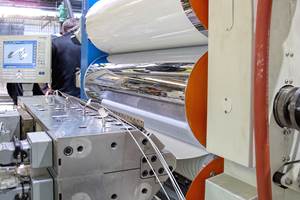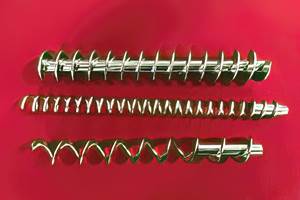Material and Process Developments Highlight SPE Automotive Awards
Custom backlighting with color-converting plastics and robotic extrusion of door seals won two categories of the 37th Innovation Awards presented in November by the SPE Automotive Div.
Custom backlighting with color-converting plastics and robotic extrusion of door seals won two categories of the 37th Innovation Awards presented in November by the SPE Automotive Div. There were also new developments in long-fiber thermoplastics and structural blow molding. (For a complete list of the awards, visit www.speautomotive.com).
COLOR-CONVERTING PLASTICS
An innovative approach to auto interior displays using color-converting plastics for custom backlighting won the Materials Award and the Grand Award. The patented system from Delphi Electronics and Safety, Kokomo, Ind., made its debut in the radio faceplate in the 2007 GM Chevy Tahoe SUV. It uses translucent polycarbonate with fluorescent dyes and proprietary light-scattering additives for molded buttons, knobs, and backlit plates. Instead of costly custom-colored electronic LEDs, Delphi uses only a standard blue LED. The dye in the plastic absorbs the high-energy blue light and re-emits it in a custom color (in this case, blue-green).
Moving color control from the LED to the plastic makes backlighting more economically feasible in low-volume niche colors. The new system reduces the number of LEDs from 30 to 5 and cuts cost by 60%. The material was produced for Delphi by compounder RTP Co. using PC resin from Bayer MaterialScience.
ROBOT EXTRUDER
Winner of the Chassis/Hardware category was the first use in the U.S. of a robotic extrusion process from Germany’s Reis Extrusion. As we reported last January (see Keeping Up With Extrusion), it was used by Faurecia Interior Systems in Frasier, Mich., to extrude a TPV seal directly on the long-glass/PP door-module carrier for the 2007 Dodge Nitro and 2008 Jeep Liberty SUVs. For this application, ExxonMobil Chemical Co. developed a Santoprene TPV grade (121-60 E 500) with low viscosity and enhanced heat stability. It is recyclable and reportedly more robust than the previous thermoset urethane foam seal.
Another finalist was the first TPV glass-run seal for a sliding door, on the 2008 Chrysler minivan. This metal-free system, molded by Jyco Sealing Technologies, Dexter, Mich., combines two special TPV coextrusions and injection molded TPV corners. The two coextrusions are inserted into the injection mold and chemically bond to the overmolded corner moldings. The three-layer coextrusions comprise hard and soft, highly crosslinked Sarlink TPVs from DSM Engineering Plastics and a top layer of Jyco’s own Jypec TPV. Jyco also used its Jybond TPV for the corner moldings.
LONG FIBERS ARE IN
Continuing a trend of the last few years, use of long-fiber reinforcements was again prominent among the awards. Winner in the Body Exterior category was the assist step for the 2007 GM Trailblazer/Envoy SUVs, molded by the Mytox Div. of Magna Decoma, Woodbridge, Ont. It was made by in-line compounding of PP and 40% long glass with a two-stage transfer injection molding process. A special rib design enabled the one-piece running board to withstand a higher load with less deflection than other composite running boards.
Another in-line long-fiber mixing-and-molding process was used for the front-end carrier of the 2007 Volkswagen Golf/Bora/Jetta, winner of the Process/Assembly/Enabling Technology category. Molded of long-glass PP from Basell, it is claimed to be the first front-end module in the U.S. to use KraussMaffei’s Injection Molding Compounder (IMC), a machine that mounts a twin-screw extruder over the plunger of a two-stage molding press.
Another structural long-fiber thermoplastic component, the front-end bolster for the 2007 Ford Edge crossover SUV, is said to be the first plastic front-end module produced at lighter weight and lower cost—even with a bolted-on metal latch brace—than overmolded metal/plastic “hybrid” systems. This finalist in the awards competition was injection molded by Meridian Automotive Systems, Allen Park, Mich., of Ticona’s Celstran 40% glass/PP.
Thermoset composites also made it to the winners’ circle. The Powertrain Award went to the electronic throttle control (ETC) module for the 2007 Chrysler Pacifica crossover, said to be the first plastic ETC in the U.S. and the first thermoset ETC ever. Injection molded BMC from Bulk Molding Compounds Inc. replaced cast aluminum. The special zero-shrink grade contained 50% glass/mineral filler.
STRUCTURAL BLOW MOLDING
Blow molding continues to win in automotive. The Performance and Customization Award went to the stowable bed extender for the 2006 Ford 250/350 pickup. It is claimed to be the first blow molded pickup bed extender, which replaces roll-formed steel or aluminum profiles. The two-piece bed extender is molded of 15% glass-reinforced PP from Salflex Polymers, the custom compounding branch of ABC Group, another division of which molded the part. It measures 26 x 17 x 4 in. and weighs 20 lb.
A finalist in the Body Exterior category was the tubular blow molded composite running board for the 2007 Chrysler Jeep Wrangler JK SUV. It replaces two injection molded parts that are welded together. A new 20%-glass PP grade from A. Schulman reportedly provides high melt strength and Class A surface for this 1880-mm-long part, molded by Magna Decoma’s Mytox Div.
Related Content
Medical Tubing: Use Simulation to Troubleshoot, Optimize Processing & Dies
Extrusion simulations can be useful in anticipating issues and running “what-if” scenarios to size extruders and design dies for extrusion projects. It should be used at early stages of any project to avoid trial and error and remaking tooling.
Read MoreRoll Cooling: Understand the Three Heat-Transfer Processes
Designing cooling rolls is complex, tedious and requires a lot of inputs. Getting it wrong may have a dramatic impact on productivity.
Read MorePart 2 Medical Tubing: Use Simulation to Troubleshoot, Optimize Processing & Dies
Simulation can determine whether a die has regions of low shear rate and shear stress on the metal surface where the polymer would ultimately degrade, and can help processors design dies better suited for their projects.
Read MoreWhat to Know About Your Materials When Choosing a Feeder
Feeder performance is crucial to operating extrusion and compounding lines. And consistent, reliable feeding depends in large part on selecting a feeder compatible with the materials and additives you intend to process. Follow these tips to analyze your feeder requirements.
Read MoreRead Next
Beyond Prototypes: 8 Ways the Plastics Industry Is Using 3D Printing
Plastics processors are finding applications for 3D printing around the plant and across the supply chain. Here are 8 examples to look for at NPE2024.
Read MoreLead the Conversation, Change the Conversation
Coverage of single-use plastics can be both misleading and demoralizing. Here are 10 tips for changing the perception of the plastics industry at your company and in your community.
Read MoreSee Recyclers Close the Loop on Trade Show Production Scrap at NPE2024
A collaboration between show organizer PLASTICS, recycler CPR and size reduction experts WEIMA and Conair recovered and recycled all production scrap at NPE2024.
Read More












